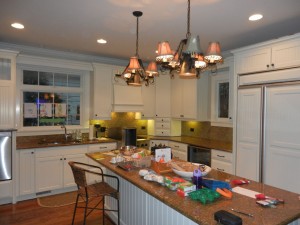Since the beginning of the last downturn in the housing market, refinishing kitchen cabinets has become a very worthwhile and cost effective alternative for consumers. There are numerous options. They range from toning previously stained/varnished cabinets to painting them and perhaps adding a glaze to accentuate the contours, with a lot of options in between.
An increasingly popular cabinet finish is the hand-painted look. Those are some of the most expensive cabinets in the market today. When hand-painting cabinets, brush marks are created, which is part of the appeal. However, the key for producing a professional result is to manage the brush marks, so that they are uniform, light and follow the grain patterns of the cabinet components, while avoiding blemishes such as sags and misses. Based on our long experience at refinishing cabinets in the Chicago area, here is a list of ten professional techniques we use to produce the best possible result.
– Use 350-grit sandpaper to avoid creating scratches.
– Since the primer and paint are likely to be waterborne, we recommend the use of a vacuum cleaner, instead of tack-cloth, to avoid
surface contamination after sanding.
– The profile of the cabinet doors will dictate the size brushes to use. Brushes as small as one inch may have to be used. Two-inch
brushes are the largest brushes we recommend. Larger brushes load too much paint on the surfaces.
– Four-inch mohair rollers can be used as paint applicators on flat surfaces., which are then lightly brushed out.
– A bonding primer should be used to ensure maximum adhesion and then lightly sanded.
– Maintaining a wet edge is critical during painting. Wiping off edges may be necessary to avoid creating overlaps.
– The primer and paint should be applied from the center panel, outward.
– Waterborne paints dry quickly. It may be necessary to strain the paint if debris is detected in the paint.
– Cleaning brushes every two or three hours will also reduce the risk of paint contamination from flaking paint.
– Use an abundant source of natural light when painting to ensure a uniform, flawless finish. It is important not to rush the process.
Refinishing kitchen cabinets is not only economical, but is also good for the environment. Producing a professional hand-painted look for cabinets adds panache and flair to your kitchen.








 Follow
Follow
